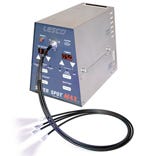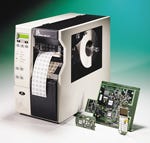May 1, 2001
Originally Published MPMN May 2001
HOTLINE
Product Labels Dissipate Electrostatic Energy
Safe for use with electronic components
|
Labels use special adhesive to eliminate dangerous electrostatic energy. |
Electrostatic-dissipating labels from Zebra Technologies Corp. (Vernon Hills, IL) reduce the risk of static-related damage to sensitive electronic components during manufacturing, assembly, and packaging. Suited for quality control, item identification, and other applications, the labels are certified by the Electrostatic Discharge Association to effectively dissipate electrostatic energy and not damage the boards they identify. According to R&D manager Gene Hofer, ESD "can change the electrical characteristics of a device and upset the normal operation of an electronic system, causing equipment malfunction or failure." A special layer on the backside of the film and an antistatic ingredient in the adhesive eliminate the triboelectric charge that is produced when a label is removed from its silicone liner. The ESD Association estimates that conventional products may cause static-related damage to as many as one in three boards. In many cases, the damage may not be detected until consumer use. The ESD stickers work with Zebra's high-resolution printers to form a complete system capable of producing scannable and readable text labels for even small components. The labels withstand high-temperature manufacturing processes, including wave soldering and infrared reflow. Zachary TurkeFor more information, contact Zebra Technologies Corp., 333 Corporate Woods Pkwy., Vernon Hills, IL 60061-3109; ph: 847/634-6700; fax: 847/913-8766; URL: www.zebra.com.
High-Yield Medical-Grade Styrene Acrylic IntroducedCopolymer offers processing and cost advantages over acrylicA new grade of styrene acrylic copolymer is less costly to produce than acrylic but provides the same alcohol, blood, and lipid resistance. The NAS 90 copolymer was formulated by Nova Chemicals (Pittsburg) for medical applications. According to Nova Chemicals' vice president of high-performance styrenics Eric Kelusky, NAS 90 processes like polystyrene, but has strength and clarity similar to acrylic. "NAS copolymers yield more parts per hour with lower energy costs because of lower processing temperatures and shorter cycle times," he adds. The NAS 90 copolymer has the strength and clarity of acrylic but requires less time and energy to process.The copolymer is FDA registered, meets USP Class VI specifications, and withstands gamma and EtO sterilization. It is compatible with tooling designed for many other resins such as acrylic, vinyl, and polycarbonate. The material can be blended with clear impact modifiers to improve toughness, is scratch resistant, and resists hazing when exposed to alcohol or other cleaning chemicals. Applications include respiratory valves, yankauer section tubes, and urine meters.Katherine Sweeny For more information, contact NOVA Chemicals Corp., P.O. Box 2518, Station M, Calgary, Alberta, Canada T2P 5C6; ph: 403/750-3600; fax: 403/269-7410; URL: www.novachem.com.
The NAS 90 copolymer has the strength and clarity of acrylic but requires less time and energy to process.The copolymer is FDA registered, meets USP Class VI specifications, and withstands gamma and EtO sterilization. It is compatible with tooling designed for many other resins such as acrylic, vinyl, and polycarbonate. The material can be blended with clear impact modifiers to improve toughness, is scratch resistant, and resists hazing when exposed to alcohol or other cleaning chemicals. Applications include respiratory valves, yankauer section tubes, and urine meters.Katherine Sweeny For more information, contact NOVA Chemicals Corp., P.O. Box 2518, Station M, Calgary, Alberta, Canada T2P 5C6; ph: 403/750-3600; fax: 403/269-7410; URL: www.novachem.com.
UV Curing System Uses Fiber OpticsUnit resists energy loss and degradation Fiber-optic light guides on the FiberFire curing system increase efficiency and longevity.
Fiber-optic light guides on the FiberFire curing system increase efficiency and longevity.
An alternative to conventional liquid-transmission machines, a curing system uses fiber optics to precisely deliver UV light in an array of medical manufacturing applications. The FibreFire system from Lightwave Energy Systems Co. (Torrance, CA) works in combination with the company's line of lamps to direct 30 W/cm2 cm of A-range UV light to adhesives, coatings, and inks. With a total optical power of 50 W/cm2, the machine can also produce UVB, UVC, and visible light. Special fiber construction minimizes energy loss, delivering 25% of the source light to the end of each strand. The use of fibers also eliminates some of the degradation problems associated with fluid-based systems. The system "still degrades slowly," says sales manager Phil Smith, "but only through the bulb, not the fiber-optic light guide." Custom configurations allow multiple points to be cured simultaneously or in rapid succession. Heat controls enable the system to be used with thermally sensitive materials. Optical-feedback intensity control ensures consistent output and a guaranteed lamp life of 1000 hours. Real-time data acquisition and user-programmable NIST calibration are among other features of the system. Zachary TurkeFor more information, contact Lightwave Energy Systems, 23555 Telo Ave., Torrance, CA 90505; ph: 310/784-2930; fax: 310/784-2929; URL: www.lescouv.com.
Medical Product Manufacturing News is always on the lookout for innovative products and services. If you are aware of any that have recently been or are about to be introduced, please call the Hotline editor, Karim Marouf, at 310/445-4267.
Copyright ©2001 Medical Product Manufacturing News
You May Also Like



